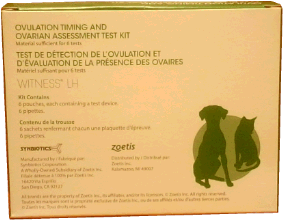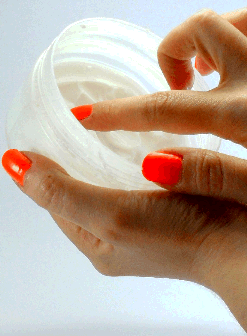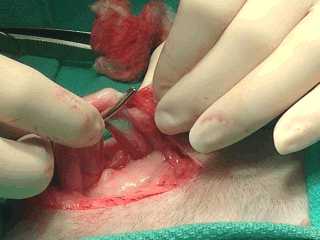|
OVARIAN REMNANT SYNDROME

Whether the patient is a dog or a cat, ovarian remnant syndrome is suspected when a spayed female pet appears to be coming into heat, something that should be impossible after spaying. A spayed female has had both her ovaries removed and should not cycle and should not display behaviors typical of heat. If she is displaying signs of an active heat cycle, a search for an estrogen source is required. In particular, we need to rule out a piece of ovarian tissue left inside. If a piece of ovary (or similarly active tissue) is indeed inside, the only treatment is surgically removing it and since this is an invasive solution, we want to be as certain as possible that there is no other likely explanation.
|
THE GIRL DOG IN HEAT
The female dog comes into heat every 6-8 months on the average. During this time, the most prominent feature is the vaginal discharge which begins bloody and switches to a more golden “straw color.” The girl dog in heat will attract males and will most likely flirt playfully with them. This period of hormonal activity lasts about 3 weeks and culminates in a false pregnancy (or potentially a real one if she has been bred). The false pregnancy period lasts roughly a couple of months.
THE GIRL CAT IN HEAT
The female cat in heat does not have an apparent vaginal discharge. For her, the signs of heat are more behavioral. She becomes restless, and loudly vocal. She may urinate in the house in an attempt to notify local tomcats of her state. She is often unusually affectionate and has a tendency to stick her rear in the air and even tread her feet when she is petted over her back.
|

(original graphic by marvistavet.com)
|
|
The female cat cycles seasonally, when the days are longer, and tends to stop cycling when the days begin to get shorter. She is in heat for 5 days or so and then out of heat for a couple of weeks, then back in, then back out over and over until she is either bred or the seasons change. If she is bred, she will ovulate and go into a false pregnancy (or a real one if the breeding was successful). In any case, it is the behavior that is the clue that her hormones are active, especially since the occasional female cat will not follow the usual rules about the seasons.
Signs of heat (also referred to as “estrus”) imply estrogen in the pet’s system.
The first step is to confirm that estrogens are genuinely present.
|

(original graphic by marvistavet.com)
|
|
TESTING FOR HORMONES
Vaginal Smear
One might expect a blood test to be necessary to look for the presence of estrogen or progesterone but, in fact, the best test is a vaginal smear test, at least for dogs. Using a Q-Tip, the veterinarian can harvest some cells from the vaginal wall and look at them under the microscope. If the female is in heat at the time of the test, the cells will have a very characteristic appearance called “cornification.” This means there are estrogens in her body.
|

(original graphic by marvistavet.com) |
Blood Testing
Testing for estradiol, one of the estrogen hormones, can be done but is not as accurate as the vaginal smear test. If the spayed female has high estrogen levels during the time she appears to be in heat, this would be considered a positive test. The problem is that low levels can still be present in the bloodstream in even if there is an ovarian remnant so low levels are hard to interpret.
Another approach is to give her a shot of GnRH (Gonadotropin Releasing Hormone) while she appears NOT to be in heat. If she responds to the injection by producing progesterone two weeks later (detectable with a blood test), this would be consistent with an ovarian remnant.
The vaginal smear costs a fraction of the amount of blood testing and can generally be done in a matter of minutes in the doctor’s office so these types of blood tests are rarely performed.
|
Witness LH and SpayChek® Testing
There is an in-house test kit for luteinizing hormone (“LH”) which can determine if a female cat or dog has been spayed or not provided she is not experiencing a heat at the time of the test. This test could be performed to assist in diagnosis but would have to be done during a time when symptoms of heat were not present. A low LH level is compatible with the presence of estrogen (and presumably ovarian tissue).
The newer “spay check” test for anti-mullerian hormone is reportedly more reliable but requires that at least 2-3 months have passed since the original spay surgery for accuracy. It is best performed in conjunction with a progesterone level for best accuracy.
Your veterinarian may suggest more than one type of test to be sure there is little room for ambiguity. After it is clear that estrogens are definitely present, the next question to address is:
|
 Witness LH Test Kit Witness LH Test Kit
(original graphic by marvistavet.com) |
WHERE DID THEY COME FROM?
|
ESTROGEN CREMES FOR HUMAN USE
Topical estrogen-containing crèmes have numerous human uses. These crèmes invariably end up on the user’s hands or arms where a loving pet can lick them. A female pet exposed to a hormone crème in this way can easily manifest signs of heat but will not show a hormone cycle in any predictable way. Generally, people are aware that hormone crèmes are in use at home and can be more careful about avoiding exposure to pets. Cremes may be applied using gloves which can be discarded away from the pet, hands can be washed carefully etc.
|
 (Photocredit: Morguefile.com) (Photocredit: Morguefile.com) |
DID SOMETHING GO WRONG WITH THE ORIGINAL SURGERY?
 (original graphic by marvistavet.com) (original graphic by marvistavet.com) |
One would think that if there is a remnant of ovarian tissue in the spayed pet’s abdomen, the surgeon must have left it behind. This is not necessarily so. It appears that some females possess accessory ovarian tissue separate from the main ovary and this tissue becomes active only after the main ovaries are removed. Some cats actually grow invisible ovarian tissue down the length of their ovarian ligament which is cut during the spay surgery but not fully removed. Further, if an ovary contacts the abdominal wall, cells appear able to adhere and vascularize effectively creating a new, albeit small, ovary. In many cases the original spay surgery was performed months or even years before. These secondary bits of ovary are growing in this time and do not show themselves until they have achieved sufficient hormone producing power. Once it has been determined that an ovarian remnant is present, surgery should be performed to locate and remove it.
It is worth mentioning that adrenal tumors can produce hormones. These can be difficult if not impossible to remove but exploratory surgery should at least identify their presence over an ovarian remnant. In the situation of this type of tumor, signs of heat are constant; they do not cycle as with ovarian tissue.
|
TREATMENT
The ovarian tissue will be most prominent/visible just following the active heat period. This is the time after ovulation when the ovary is normally ripe with large progesterone-secreting structures called “corpora lutea” and this is the best time for surgical exploration. If errant ovarian tissue is found, it can be removed generally without difficulty. It is not unheard of, however, for the ovarian remnant or remnants to be impossible to find. Referral to a surgery specialist may be necessary to find them. Biopsy of the removed tissue should settle the question as to whether the hormone source was removed intact or not.
WHY DO WE NEED TO DO ANYTHING AT ALL?
The problem with all this is not limited to the inconvenience of hormone-related behaviors and discharges. The actual problem is that hormones can cause harm. Long term exposure to female hormones can promote mammary cancer. If a small piece of uterus persists after spaying, the influence of female hormones can promote chronic infection ("stump pyometra"). While neither of these outcomes are definite, their repercussions are serious and it is best to take these hormones out of play.
WHAT IF IT ISN’T HEAT?
Female dogs can have a bloody vaginal discharge for reasons other than heat. It is possible the owner is actually seeing bloody urine, for example, and the medical work up will need to shift to address the different causes of this problem. Alternatively, a transmissible venereal tumor, urinary tract infection, or vaginal injury might lead to bleeding.
As for the female cat, she may simply have behavioral issues to address.

Page posted: 10/21/2013
Page last updated: 1/13/2023
|